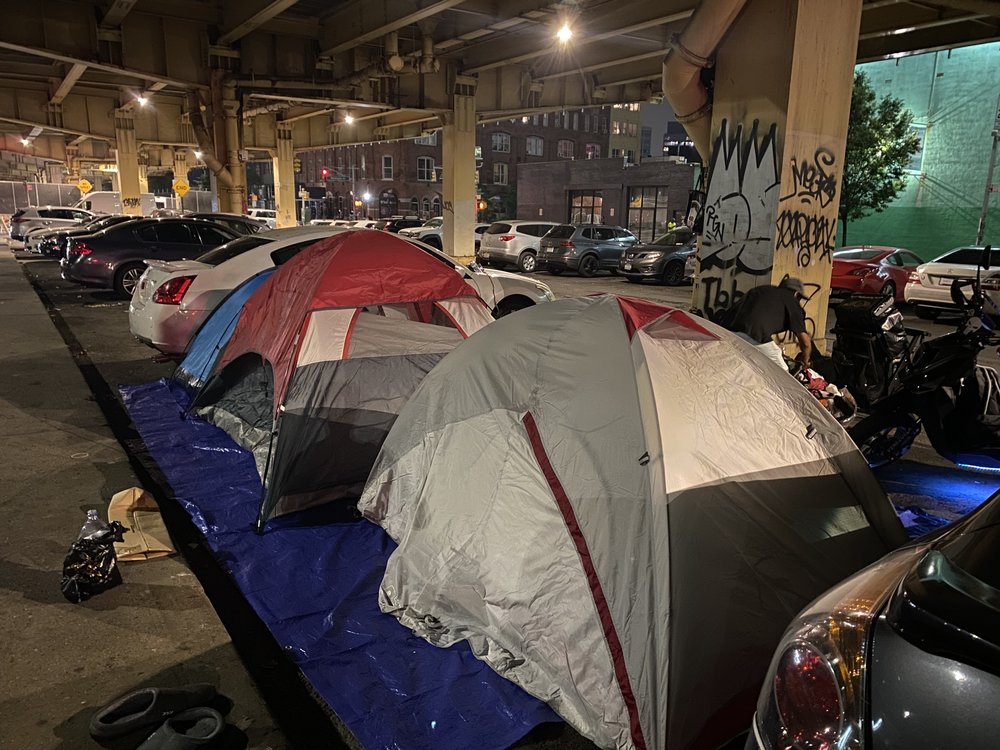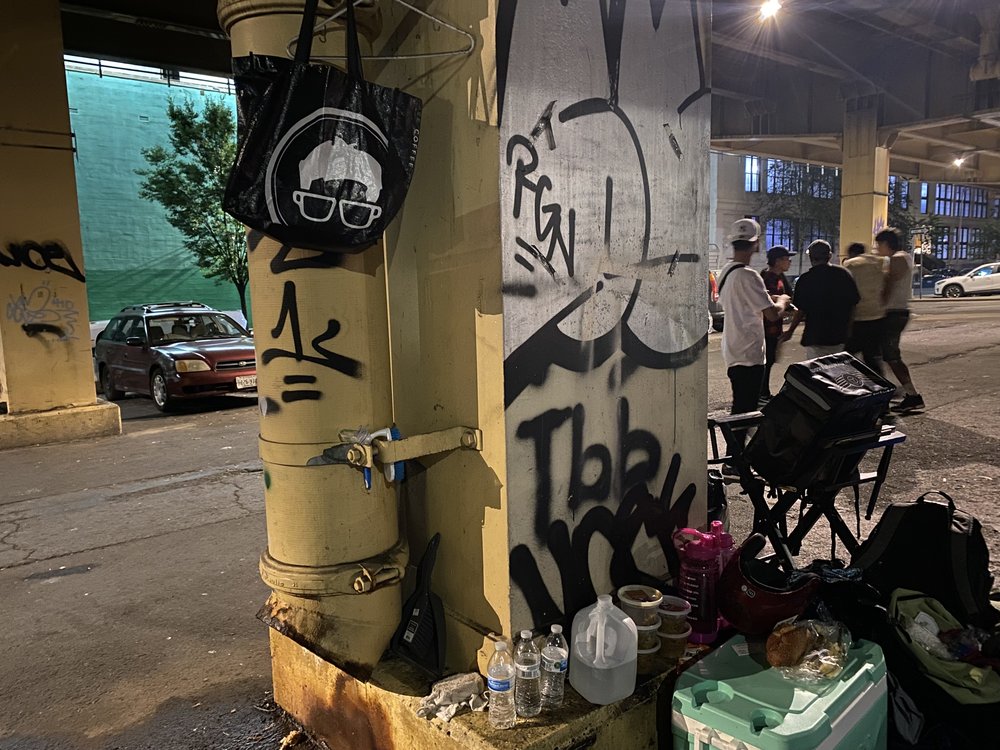For some migrants in NYC, a tent encampment under the BQE is now home
July 20, 2023, 8 a.m.
Housing advocates say to expect more such encampments if Mayor Adams retreats on the city’s long-standing obligation to provide shelter to those who need it.

As Mayor Eric Adams seeks to shorten the stays of migrants filling the city’s shelter system, displaced new arrivals are creating their own living spaces – under the Brooklyn-Queens Expressway.
In recent days, a dozen men, mostly migrants ejected from a nearby city-run respite center, have formed a small encampment – three tents tucked between parked cars, with a comforter functioning as a padded floor – on the edge of Clinton Hill, near the Brooklyn Navy Yard.
While the men told Gothamist on Wednesday they took some comfort from their joint arrangement, the appearance of tents, along with the presence of hundreds of migrants in the nearby Hall Street respite center, has caused a ripple of alarm among Clinton Hill residents, who complained of a lack of communication by the city.
And housing advocates said such encampments, rare for New York City, could well become the rule if Adams succeeds in retreating on the city’s long-standing obligations under right-to-shelter rules to provide shelter to all who need it.
On Wednesday, the Adams administration announced new approaches to dealing with the growing numbers of asylum seekers arriving in the city, including instituting a 60-day limit on shelter stays for some migrants, a change city officials say is meant to free up space for children and families in the system.
At the same time, the administration is asking a judge to relieve the city of its obligations under the shelter rules, which have been in place for decades.

The Adams announcement was met with pushback by advocates for homeless New Yorkers.
“Any weakening of these rights will result in thousands more people sleeping on our streets and in the transit system – a potential reality that no New Yorker wants,” said Legal Aid Society and Coalition for the Homeless in a joint statement on Twitter.
David Giffen, the executive director of Coalition for the Homeless, said it was imperative that the city not allow the problem of street homelessness among migrants to grow, if it wanted to avoid resembling large cities on the West Coast, where tent encampments line block after block.
“Cities like Los Angeles and San Francisco have vast tent encampments because they don't have the right to shelter and they don't have enough affordable housing,” said Giffen in an interview with Gothamist.
Cities like Los Angeles and San Francisco have vast tent encampments because they don't have the right to shelter and they don't have enough affordable housing.
David Giffen, executive director of Coalition for the Homeless
“New York City doesn't have enough affordable housing but we have this baseline of decency which is the legal right to shelter,” he said, “and that is what has kept the city from having those sprawling tent encampments that you see in other cities, so it's critical that we not erode that right to shelter in any way.”
The city’s shelter population has topped 103,000, including more than 53,000 migrants who have arrived since spring a year ago. So far, said Giffen, his organization had not encountered many asylum seekers living on the streets of the city.
The Adams administration has made moving homeless people out of public spaces a priority, though advocates say the real problem is a lack of affordable housing, including at the lowest income levels.
Under the Brooklyn-Queens Expressway
One of the residents of the encampment beneath the BQE, Junior, is a 26-year-old migrant from Venezuela, who asked that his full name not be used because of his lack of permanent immigration status.
Inside the encampment on Wednesday were the meager belongings of the group: bottles of water, plastic containers of food distributed by mutual aid groups, and a cooler. Overhead, a large tote bag hung from a drain pipe
After being kicked out of the respite center on Hall Street, Junior and a fellow migrant initially slept out in the open for two weeks, on a discarded air mattress. Junior said he worried that “somebody might come by and grab me or rob me or beat me up.” The concern eased, Junior said, when he and 11 other men received tents and sleeping bags from community activists.
Junior said he felt somewhat more secure, “because we are all together.”

An aide to Adams confirmed that shelter residents had been asked to leave the Hall Street respite center, but added they were permitted to re-register for housing elsewhere.
“The health and safety of asylum seekers in our care is always a top priority,” City Hall spokesperson Kayla Mamelak said in a statement. “Those refusing to follow the code of conduct at any of our sites will be asked to leave in order to protect those looking for safe shelter for themselves and their families.”
One of the migrants living on the street with Junior, 28-year-old Carlos, acknowledged having violated the rules of the facility, but said he and others had been provoked and that security guards had been physically and verbally abusive to the migrants. He also spoke on condition that his full name not be used, because of his lack of permanent immigration status.
“I’m not gonna lie, I was part of the fight, but not when it started,” said Carlos, who sports a tattoo on one arm showing the Statue of Liberty waving an automatic gun at the sky, and the words “La Mafia” underneath.
“I was at my cot and then everyone started shoving each other,” he explained, “and then the security guards started to shove us, trying to put all the Venezuelans in a corner. And I was part of it, and people were throwing mattresses and shoes.”
Cramped conditions, rising tensions
Mutual aid volunteers and other advocates for the migrants said conditions inside city-run facilities have led to increasing tensions. The Hall Street site has two shower trailers outside but no showers inside, and residents said it has few toilets. Videos circulated among migrants show that one or more of the toilets inside what they said was the Hall Street site was closed for repairs.
“The shelter system is a labyrinth of rules and staff can kick anyone out for any reason, including being unruly,” said Sergio Tupac Uzurin, a mutual aid worker and spokesman for NYC ICE Watch. “Which in these conditions is not that hard to do if there’s a hundred men waiting in line for one toilet.”
Some long-time residents who live in the vicinity of the shelter and the encampment said the issue of migrants living on the street – as well as in the nearby shelter itself – had become a heated topic of conversation. Some of the neighbors people feel caught between wanting to support the migrants and yet also worrying about the long-term impact on the community.
“It is deeply unsettling to know and see that these men have been dropped into the neighborhood, after a potentially horrific plight, without any resources to support their settlement at all,” said Clinton Hill resident Christa Capati, adding “a lot of neighborhood residents feel really let down by the city and government” for failing to engage the public on the issue.
“We don’t know how long the shelter will remain in place and there has already been a big increase in the amount of foot traffic, a huge amount of litter which is adding to an existing rat problem and there are security concerns being shared by many neighbors,” said Capati, who has lived in the neighborhood for nearly eight years.
Additionally, she noted that “with nowhere for migrants to go,” Washington Hall Park, at the corner of Hall Street and the BQE, had become the default gathering spot for the men.
“Meaning that many families feel uncomfortable taking their children there to play or use the sprinklers and single female residents are no longer using the space to workout or walk pets,” she said.
A 12-hour shift brings in $80
Junior arrived in New York three months ago, saying he left Venezuela “because of the government, because of the dictatorship” of President Nicolas Maduro.
Initially, he was placed at a hotel in Jamaica, Queens, before being transferred to Hall Street, and was ejected after a week, not for fighting but because he slept on the floor one night. He said he had secured permission to do so after finding it impossible to sleep on his cot.
“It's impossible to sleep in there, it hurts your spine,” he said, adding that he was woken up at 7 in the morning and told to leave the facility.
Since then, he and the other men have earned some money from odd jobs.
“I’ve washed dishes, I’ve done deliveries, I’ve worked on houses, doing renovations,” said Junior. “The only issue is, because I don’t have my papers, there’s nothing steady. They only hire me for a week and then let me go.”
A 12-hour shift at a deli, he said, brought in $80.
“So right now I'm sleeping on the street and looking for work,” said Junior. “It's hard work just sleeping on the street.”
Mayor Adams gives single adult migrants 60-day notice to leave shelters How Mayor Adams was able to bypass NYC’s decades-old right-to-shelter rules Mayor Adams' homeless encampment sweeps result in just 115 people entering NYC shelters